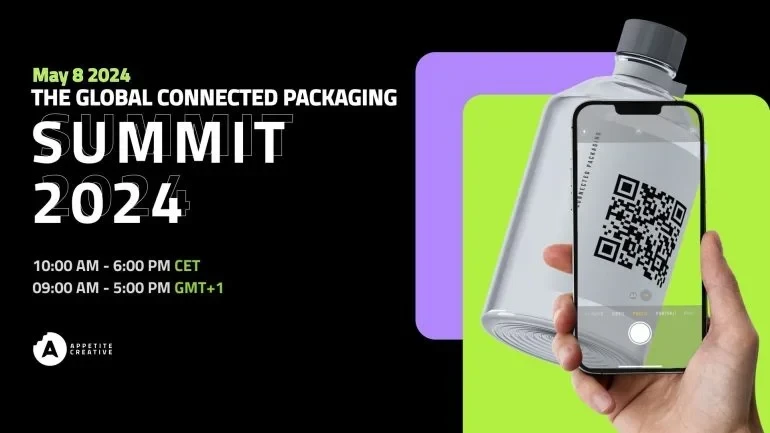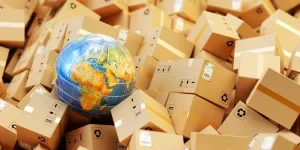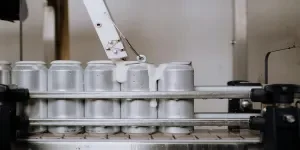From driving data-driven insights to fostering deeper customer connections, the summit unveiled next-level strategies for businesses to thrive in a digitally evolving marketplace.

Back by popular demand, we presented our fourth annual virtual Global Connected Packaging Summit earlier this month, featuring technology, innovation, packaging, branding and sustainability experts sharing insights, advice and topical discussions.
At the summit, we showcased how businesses can adopt connected packaging to create engaging customer experiences, gather valuable first-party data and drive increased sales.
We took a deep dive into the evolving landscape and discovered new strategies to enhance brand competitiveness in our digital world. With over 500 registered attendees from across 43 different countries attended, the summit showcased 18 speakers across 11 thought-provoking discussions and presentations. The speakers answered over 60 live questions from the audience.
According to our third annual connected packaging survey released earlier this year, the perceived value of data collection through connected packaging is rising, especially in the context of the imminent demise of third-party cookie data. We found sustained interest over the last 12 months with 82% of those surveyed stating they have used connected packaging, compared to over four-fifths (81%) from the survey released in 2023 and over half (54%) in 2022.
Building on this research, during the summit I wanted to uncover new ways brands can tap into this evolving technology. There were lots of brilliant insights shared during the day and my key takeaways from the discussion include:
1. Overcoming barriers
Mohamed Bassyouny at SIG, Stuart McLellan at Delga Press and Zakithi Mncwango at Nestlé discussed sustainable innovations and digital solutions in connected packaging, and the benefits for manufacturers in terms of product control, accuracy, and consumer engagement.
Connected packaging can enhance consumer interactions and trust, by supplying more detailed information and personalised experiences. Examples included innovative uses of QR codes for product information and engagement, such as Kellogg’s use for accessible labelling and a cosmetics brand using invisible conductive ink for personalised tutorials.
Challenges discussed included cost, resource allocation, and data privacy. The importance of starting with pilot projects and using labels for QR codes was suggested as a cost-effective approach. Technology’s role in overcoming these hurdles, particularly with the aid of trusted partners, was highlighted.
Looking ahead, AI and immersive technologies will offer more sophisticated interactions between consumers and brands. These innovations promise to further integrate virtual and physical experiences, enhancing consumer engagement and brand loyalty. Connected packaging has the potential to revolutionise the market through meaningful, consumer-centric solutions.
2. Packaging as a media channel
Katie Livesley at Dentsu UK and Gregor Murray at DCG assessed connected packaging’s value as a new media channel. Control and value of consumer data was deemed the main benefit, which is often mediated by giants like Amazon. Winning brands will bypass these intermediaries to establish direct consumer connections.
Successful examples include Red Bull and Lego, who effectively use user-generated content and community engagement. The conversation also emphasised the importance of understanding and mapping the customer journey to make packaging relevant and valuable, highlighting the need for agility and collaboration across media channels.
Challenges include cost, technological adoption, and changing consumer behaviour, requiring manufacturers to become more creative and agile. Experimentation, testing, and learning are vital for innovation. The key advice for brands was to innovate meaningfully and ensure that packaging innovations align with brand values and consumer relevance.
3. Data analytics & insights
Gemma Rollason at Peasy highlighted that the integration of AI technology enriches data collection, providing insights into consumer behaviour and material composition, helping brands optimise their operations. Consumer data reveals the importance of understanding behaviour patterns, product usage, and supply chain tracking. Brands can prioritise data based on their specific needs, offering a flexible approach to connected packaging.
KFC in South Africa was a case study she shared that illustrates the benefits of such systems, showing significant behaviour changes and brand perception improvement through gamified rewards. It offers substantial potential for sustainability, customer engagement, and data-driven insights, encouraging brands to innovate and adopt these technologies for comprehensive benefits.
Thomas Vollmuth, Koenig & Bauer highlighted that brands struggle with customisation, reaction times to ingredient changes, and waste from unused packaging. To address these challenges, he emphasised the importance of variable data printing (VDP) for connected packaging.
VDP allows for unique codes on products, enabling direct consumer interaction, product authentication, loyalty programs and personalised marketing. This approach supports brand protection and compliance with regulations such as the European Digital Product Passport. Digital printing technology facilitates faster time-to-market, enhances consumer engagement, and contributes to sustainability by reducing waste. The digitalisation of packaging, combined with VDP, offers brands innovative ways to connect with consumers, differentiate their products, and meet future market demands.
4. Product protection & authentication
There are three main drivers for connected packaging: marketing, regulatory compliance, and anti-counterfeiting.
Gavin Gerr at Laava explained that counterfeiting is a major problem, costing some economies more than they produce. Traditional authentication methods like QR codes can be easily spoofed. Laava uses digital fingerprints, invisible dots, and special logos to mark products. These are scanned by consumers, and suspicious activity triggers alerts. This protects consumers from potentially harmful fake products, and helps businesses maintain their brand integrity and profitability.
In an example with Croc’s shoe brand Hey Dude, Laava helped them not only with counterfeiting but also with identifying diverted products from authorised channels. Gavin explained that Laava can be set up to change the consumer experience, such as displaying a warning message, if a product is scanned too many times.
When surveyed, 38% of the conference attendees stated that authentication is extremely important when making a purchase decision, and somewhat important to over half (52%).
5. Meaningful customer engagement
Consumers are interested in interactive features and educational experiences. Connected packaging can be used for good, such as educating consumers about sustainability or donating to charity.
Acknowledging the complexities of sustainability-driven consumer choices and the evolving landscape of brand-consumer relationships, connected packaging can facilitate meaningful engagement, foster sustainability and drive positive change.
Stefan Hills at Linked2Brands underscored how connected packaging transforms consumer engagement, turning static interactions into dynamic feedback loops. He emphasised the instant gratification and value exchange for both consumers and brands.
Marco Macoratti at Linked2Brands pointed out that connected packaging isn’t just about data capture but can also foster sustainability initiatives and social impact.
This year’s summit looked at the tried and tested benefits of connected packaging. From the benefits gleaned across data and insights, to education and customer loyalty. It is an essential tool across authentication, marketing and regulatory compliance. No longer a whim for brands to include on media plans, connected packaging is here to stay.
About the author: Jenny Stanley is Managing Director at digital experiences studio Appetite Creative.
To watch the Global Connected Packaging Summit summit click here.
Source from Packaging Gateway
Disclaimer: The information set forth above is provided by packaging-gateway.com independently of Alibaba.com. Alibaba.com makes no representation and warranties as to the quality and reliability of the seller and products.




